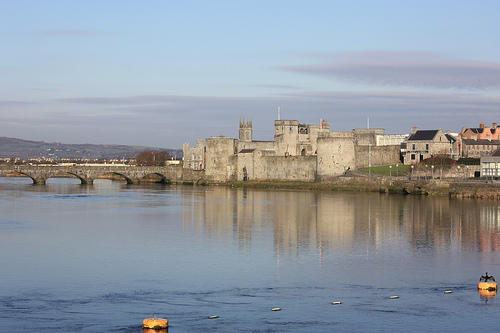

Location: Limerick Map
Constructed: 1197- 1200
King John's Castle is a massive medieval fortress on the banks of river Shannon in a city of Limerick, Limerick County in Ireland. King John's Castle was constructed in 1197- 1200.
The first stable bastion on the "King's Island" is due to the
Viking king Thormodr Helgason, who built a base here in 922 to be
able to dominate the entire extension of the Shannon River from
Lough Derg to Lough Ree, attacking religious settlements. In 937,
the Vikings established in Limerick faced the Dublin at Lough Ree,
and were defeated by them. In 943 they were again defeated when the
head of the local clan joined Ceallachan, King of Munster, and the
Vikings of Limerick were forced to pay tribute. The power of the
Vikings never recovered, and they were reduced to a smaller clan,
yet they played an important role in some of the endless power
struggles that shook Ireland during the later centuries.
The arrival of the Normans in the area in 1172 completely changed
the situation. Domhnall Mor O'brien completely destroyed the city in
1174, in an attempt to prevent it from falling into the hands of the
new invaders. The Normans finally captured this area under John I of
England, Lord of Ireland. In 1197, Limerick was believed to have
received his first fueros and his first mayor, Adam Sarvant. At this
time, the construction of a castle under the orders of King John
began, which was completed around 1200.
During this period of peace imposed by Norman rule, Limerick
prospered as a port and as a shopping mall. The city had been
divided into two zones: the one that was known as the "English town"
English Town), in the "Isla del Rey" (King's Island), and the "irish
city" (Irish Town), on the south bank of the river. The castle had a
more administrative than military function at the time, including
coin minting.
The castle, especially its outer walls, was severely damaged during
the siege of Limerick which took place in 1642, and which was only
the first of the five sites the city suffered in the 17th century.
In 1642, the castle was occupied by Protestants fleeing the Irish
Rebellion of 1641, and was surrounded by an Irish Confederate force
commanded by Garret Barry. Since Barry had no heavy artillery, he
decided to mine the castle walls by digging under its foundations.
The occupants of the castle surrendered when Barry was on the verge
of achieving the collapse of the walls. In fact, the damage to its
foundations was so severe that part of the outer wall had to be
demolished later.
The castle lived its last site in 1691, during the war between
Jacobites and Wilhelmists (supporters of William III of England),
which ended with the signing of the Treaty of Limerick. Between 1791
and 1922, the castle housed a military barracks in which more than
four hundred soldiers of the British Army lived. In later times, due
to the housing shortage in Limerick, houses were built inside, which
were later eliminated.
Today, the castle has been equipped as a tourist attraction, with a
visitor center where dramatizations and exhibitions about the
history of the castle are offered.